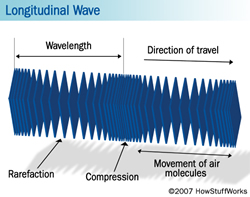Difference between Transverse and Longitudinal Waves
Key Difference: Transverse wave is a moving wave that has oscillations perpendicular to the direction of the energy transfer. In layman’s terms the wave moves perpendicular to the direction of the energy. So, if the energy is being transferred from left to right, then the wave will move up and down. Longitudinal waves, also known as l-waves, are waves have the same direction or the opposite direction as the energy transfer. In simple explanation, the waves follow the same path or the opposite path as the path of the energy transfer. So, if the energy is being transfer from right to left, then the wave will either travel left to right or right to left.
 When the word waves come to mind, the first image is a surfboard riding a wave on the beach. Although, this topic does not cover that kind of beach wave, it is similar to what we are going to talk about. A wave is simply a method in which energy is transferred through vibration. Many people are aware that sound, light, radio, uvrays and all are types of rays that are found on the planet. All of these waves can be categorized depending on way they travel and their properties. There are three types of waves that exist: transverse, longitudinal and surface wave. These first two differ in the way energy is transferred from one medium to another.
When the word waves come to mind, the first image is a surfboard riding a wave on the beach. Although, this topic does not cover that kind of beach wave, it is similar to what we are going to talk about. A wave is simply a method in which energy is transferred through vibration. Many people are aware that sound, light, radio, uvrays and all are types of rays that are found on the planet. All of these waves can be categorized depending on way they travel and their properties. There are three types of waves that exist: transverse, longitudinal and surface wave. These first two differ in the way energy is transferred from one medium to another.
Transverse wave is a moving wave that has oscillations perpendicular to the direction of the energy transfer. In layman’s terms the wave moves perpendicular to the direction of the energy. So, if the energy is being transferred from left to right, then the wave will move up and down. It is commonly how everyone imagines a wave to be on a graph. A popular example of transverse wave is light as light travels in this manner. There are two ways transverse wave can move. Let’s understand using it an example: If two people stand opposite each other and hold a string between them, followed by one person waves their hand up and down creating waves in a string. This is one method of transference. The second one is moving the same string in a back and forth motion creating a similar perpendicular motion, just horizontally rather than vertically. Radio, water, rope and electromagnetic waves all travel in a transverse wave.
 Longitudinal waves, also known as l-waves, are waves have the same direction or the opposite direction as the energy transfer. In simple explanation, the waves follow the same path or the opposite path as the path of the energy transfer. So, if the energy is being transfer from right to left, then the wave will either travel left to right or right to left. Longitudinal waves require a medium through they can pass. Mechanical longitudinal waves are also called compressional waves or compression waves, because of their ability to produce compression and rarefaction when traveling through a medium. Sound waves are an example of this type of wave. In example: two people would require a slinky this time. One person would push the slinky towards the other person who just holds it and pull it back. Notice, the rings in the middle; they will contract from one end to the other. This is how the wave will travel. Another example of longitudinal waves includes seismic P-waves that are created by explosions and earthquake. Certain electromagnetic waves when in plasma or confined spaces can be longitudinal.
Longitudinal waves, also known as l-waves, are waves have the same direction or the opposite direction as the energy transfer. In simple explanation, the waves follow the same path or the opposite path as the path of the energy transfer. So, if the energy is being transfer from right to left, then the wave will either travel left to right or right to left. Longitudinal waves require a medium through they can pass. Mechanical longitudinal waves are also called compressional waves or compression waves, because of their ability to produce compression and rarefaction when traveling through a medium. Sound waves are an example of this type of wave. In example: two people would require a slinky this time. One person would push the slinky towards the other person who just holds it and pull it back. Notice, the rings in the middle; they will contract from one end to the other. This is how the wave will travel. Another example of longitudinal waves includes seismic P-waves that are created by explosions and earthquake. Certain electromagnetic waves when in plasma or confined spaces can be longitudinal.
Surface wave is nothing more but a mixture of both transverse and longitudinal waves. This results in both of the waves existing at the same time transferring energy in different ways. The waves that we though of at the beach, they actually travel in surface waves. Other waves include Rayleigh waves and Love waves. These are most commonly seen in oceans or during earthquakes. Rayleigh waves are waves that have the same rolling motion above on the surface with a similar rolling motion following underneath. So, energy is being transferred above as well as below. This is most damaging during earthquakes. Love waves are the first kind of surface wave during an earthquake and moves the ground from side to side.
Images Courtesy: howstuffworks.com









Add new comment